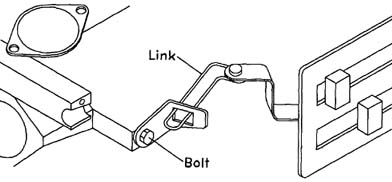

Throttle System
| Figure 6 with Table 6 show an example of a throttle system. The throttle system allows you, the driver, to control the speed at which the engine runs. As the throttle control on the engine is moved forward, the engine speed (RPM) increases. Again, as with the braking system, the system becomes more complex when a spring return is added to release the the throttle when the driver takes their foot off the pedal. Unlike the braking system, however, a spring return is required on the throttle system for the driver's safety. | |||||||||||||||||||||||||||||||||||||||||
| In order for the throttle to release to the idle position, the extension spring must be pulling against the force you provide to increase the throttle speed. To accomplish this task, mount one end of the spring to a fixed object on the frame, the other end to the throttle rod. The fixed end should be further towards the back of the go-kart than the movable end of the spring if using an EXTENSION spring, otherwise a COMPRESSION spring should be placed between a fixed stop and the rod end (see Figure 6). | |||||||||||||||||||||||||||||||||||||||||
| To control the range of throttle movement, stops need to be placed on the throttle rod or cable (Figure 6 shows stops on the rod). In general, a stop needs to be larger than the opening through which if is passing. A wire stop only needs to be larger than the housing through which the wire posses. | |||||||||||||||||||||||||||||||||||||||||
| The throttle cable itself is attached to the throttle control on the engine, and the other end is attached to the foot pedal either directly or by a throttle control rod. A throttle control rod, as shown in Figure 6, is simply a rigid connection from the foot pedal to the throttle cable. Both the throttle control cable and/or rod must be able to move back and forth freely, but with o limited range of motion as mentioned previously. | |||||||||||||||||||||||||||||||||||||||||
|
If your engine has manual friction control throttle, you will need to convert if to an adjustable governor control in order to adjust the throttle with a foot pedal. To do this you will need to follow these steps: |
 |
||||||||||||||||||||||||||||||||||||||||
|
1.) Remove the air cleaner from the engine
in order to get at the manual friction control. Your engine is now ready to accept a foot pedal controlled throttle cable. |
|||||||||||||||||||||||||||||||||||||||||
|
Figure 7 with Table 7 show how the throttle cable is attached to the Briggs and Stratton engine. This assembly requires Northern Hydraulics kit #2449, which bolts to the governor slide below the gas tank on the side of the engine. With this kit attached to your engine's throttle control, your throttle will spring back to the idle position when released. The throttle system shown in Figure 6 provides a stronger spring to accompany the spring in kit #2449, but is not necessary. |
|||||||||||||||||||||||||||||||||||||||||
|
The kill button switch allows you to shut off the engine from the drivers seat, which is important for the driver's safety. Mount the switch on the go-kart frame where if is easy to reach from the drivers seat. The spade end of the wire attaches to the ground stud on the control panel of the engine underneath the gas tank (see Figure 7); most engine manuals will inform you of where this ground stud is located on the engine. When the button on the switch is pushed, the engine is grounded and kills the electric current in the engine, thus turning it off. On some engines it may be necessary to remove the wire between the stud and the ground switch, otherwise every time the throttle is released the engine will quit. |
|||||||||||||||||||||||||||||||||||||||||
|
|
|||||||||||||||||||||||||||||||||||||||||
|
|
|||||||||||||||||||||||||||||||||||||||||
|
|
|||||||||||||||||||||||||||||||||||||||||
|
|
|||||||||||||||||||||||||||||||||||||||||
|
|
|||||||||||||||||||||||||||||||||||||||||
||
Main Home Page
||
Home Page
||
Rear Wheel/Drive Assembly
||
Front Wheel/Steering Assembly
||
Braking System
||
||
Throttle System
||
Frame
||
Engine Mount
||
Seat
||
Material List
||
Assembly Instructions
||
Before Using
||
||
Speed Calculator
||
© 2000 BuildYourOwnGoKart.com